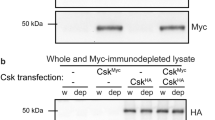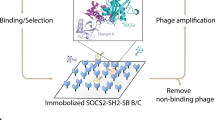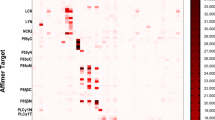Abstract
The c-src and c-yes proto-oncogenes encode 60 000 and 62 000 Dalton non-receptor tyrosine kinases of the Src family, pp60c-src and pp62c-yes, respectively. These kinases are over 80% homologous outside of their unique amino termini, yet several studies suggest that differences exist in the regulation, activation, and function of cSrc and cYes. The determinants of specificity in signaling between these proteins, however, remain unclear. In order to investigate the roles of the Src Homology (SH) 3 and 2 domains in mediating signaling specificity between cSrc and cYes, chimeras were created in which the SH3 and/or SH2 domains of cSrc or the fully activated variant Src527F were replaced by the corresponding domains of cYes. These constructs were used to assess the effects of the Yes SH3 and SH2 domains on the ability of Src to form stable complexes with and induce tyrosine phosphorylation of Src SH3 and SH2 domain binding partners in vivo. Both the Yes SH3 and SH2 domains were found to alter the capacity of Src to form stable associations with heterologous proteins. The Yes SH3 domain was unable to affinity absorb the Src SH3/SH2 binding partner AFAP-110 from COS-1 cell lysates, and chimeric constructs of Src527F containing the cYes SH3 domain were unable to efficiently co-immunoprecipitate with AFAP-110 from chicken embryo fibroblasts. Interactions with the Src SH2 domain binding partner pp130cas were unaffected. Additionally, only chimeras containing the cYes SH2 domain were able to co-immunoprecipitate with an unidentified 87 kDa tyrosine-phosphorylated protein. These results indicate that the SH3 and SH2 domains are capable of directing specificity in substrate binding between Src and Yes, suggesting potential mechanisms for generating specificity in signaling between these two highly related non-receptor tyrosine kinases.
This is a preview of subscription content, access via your institution
Access options
Subscribe to this journal
Receive 50 print issues and online access
$259.00 per year
only $5.18 per issue
Buy this article
- Purchase on SpringerLink
- Instant access to full article PDF
Prices may be subject to local taxes which are calculated during checkout





Similar content being viewed by others
References
Brickell PM . 1992 Crit Rev Onc 3: 401–446.
Cartwright CA, Coad CA and Egbert BM . 1994 J Clin Invest 93: 509–515.
Cartwright CA, Kamps MP, Meisler AI, Pipas JM and Eckhart W . 1989 J Clin Invest 83: 2025–2033.
Courtneidge SA, Dhand R, Pilat D, Twamley GM, Waterfield MD and Roussel MF . 1993 EMBO J 12: 943–950.
Erpel T, Alonso G, Roche S and Courtneidge SA . 1996 J Biol Chem 271: 16807–16812.
Fuhrer DK and Yang Y . 1996a Biochem Biophys Res Comm 224: 289–296.
Fuhrer DK and Yang Y . 1996b Exp Hematol 24: 195–203.
Guappone AC, Qian Y, Weimer T and Flynn DC . 1996 Meth Cell Sci 18: 1–11.
Guappone AC and Flynn DC . 1997 Mol Cell Biochem 175: 243–252.
Guappone AC, Weimer T and Flynn DC . 1998 Mol Carcinog 22: 110–119.
Kanner SB, Reynolds AB, Bines RR and Parsons JT . 1990 Proc Natl Acad Sci USA 87: 3328–3332.
Kanner SB, Reynolds AB, Wang H-CR, Vines RR and Parsons JT . 1991 EMBO J 10: 1689–1698.
Kefalas P, Brown TRP and Brickell PM . 1995 Int J Biochem Cell Biol 27: 551–563.
Kuriyan J and Cowburn D . 1997 Annu Rev Biophys Biomol Struct 26: 259–288.
Kitamura N, Kitamura A, Toyoshima K, Hirayama Y and Yoshida M . 1982 Nature 297: 205–208.
Kypta RM, Goldberg Y, Ulug ET and Courtneidge SA . 1990 Cell 62: 481–492.
Luton F, Verges M, Vaerman JP, Sudol M and KE Mostov . 1998 Mol Cell 4: 627–632.
Marchetti D, Parikh N, Sudol M and Gallick GE . 1998 Oncogene 16: 3253–3260.
Marengere LEM, Songyang Z, Gish GD, Schaller MD, Parsons JT, Stern MJ, Cantley LC and Pawson T . 1994 Nature 369: 502–505.
Mayer BJ and Baltimore D . 1994 Mol Cell Biol 14: 2883–2894.
Nakamoto T, Sakai R, Ozawa K, Yazaki Y and Hirai H . 1996 J Biol Chem 271: 8959–8965.
Park J and Cartwright CA . 1995 Mol Cell Biol 15: 2374–2387.
Park J, Meisler AI and Cartwright CA . 1993 Oncogene 8: 2627–2635.
Pena SV, Melhem MF, Meisler AI and Cartwright CA . 1995 Gastroenterology 108: 117–124.
Rickles RJ, Botfield MC, Weng Z, Taylor JA, Green OM, Brugge JS and Zoller MJ . 1994 EMBO J 13: 5598–5604.
Rickles RJ, Botfield MC, Zhou X, Henry PA, Brugge JS and Zoller MJ . 1995 Proc Natl Acad Sci USA 92: 10909–10913.
Roche S, Fumagalli S and Courtneidge SA . 1995 Science 269: 1567–1569.
Sakai R, Iwamatsu A, Hirano N, Ogawa S, Tanaka T, Mano H, Yazaki Y and Hirai H . 1994 EMBO J 13: 3748–3756.
Schaller MD, Bouton AH, Flynn DC and Parsons JT . 1993 Prog Nucleic Acid Res Mol Biol 44: 205–227.
Sicilia RJ, Hibbs ML, Bello PA, Bjorge JD, Fujita DJ, Stanley IJ, Dunn AR and Cheng H . 1998 J Biol Chem 273: 16756–16763.
Songyang Z, Shoelson SE, Chaudhuri M, Gish G, Pawson T, Haser WG, King F, Roberts T, Ratnofsky S, Lechleider RJ, Neel BG, Birge RB, Fajardo JE, Chou MM, Hanafusa H, Schaffhausen B and Cantley LC . 1993 Cell 72: 767–778.
Songyang Z, Carraway III KL, Eck MA, Harrison SC, Feldman RA, Mohammadi M, Schlessinger J, Hubbard SR, Smith DP, Eng C, Lorenzo MJ, Ponder BAJ, Mayer BJ and Cantley LC . 1995 Nature 373: 536–539.
Soriano P, Montgomery C, Geske R and Bradley A . 1991 Cell 64: 693–702.
Sparks AB, Rider JE, Hoffman NG, Fowlkes DM, Quilliam LA and Kay BK . 1996 Proc Natl Acad Sci USA 93: 1540–1544.
Stein PL, Vogel H and Soriano P . 1994 Genes Dev 8: 1999–2007.
Sudol M and Hanafusa H . 1986 Mol Cell Biol 6: 2839–2846.
Sudol M . 1994 Oncogene 9: 2145–2152.
Sudol M . 1998 Oncogene 17: 1469–1474.
Thoms SM and Brugge JS . 1997 Annu Rev Cell Dev Biol 13: 513–609.
Tsygankova OM, Peng M, Maloney JA, Hopkins N and Williamson JR . 1998 J Cell Biochem 69: 63–71.
Weng Z, Thomas SM, Rickles RJ, Taylor JA, Brauer AW, Seidel-Dugan C, Michael WM, Dreyfuss G and Brugge JS . 1994 Mol Cell Biol 14: 4509–4521.
Weng Z, Rickles RJ, Feng S, Richard S, Shaw AS, Schreiber SL and Brugge JS . 1995 Mol Cell Biol 15: 5627–5634.
Zhao Y, Krueger JG and Sudol M . 1990 Oncogene 5: 1629–1635.
Zhao Y, Uyttendaele H, Krueger JG, Sudol M and Hanafusa H . 1993 Mol Cell Biol 13: 7507–7514.
Zhou S and Cantley LC . 1995 Trends Biochem Sci 20: 470–475.
Acknowledgements
DC Flynn was supported by the NIH grant CA60731 and a grant from the Emmett G and Brownie E McDowell Fund supported this work. JM Summy was supported by the Arlen G and Louise Stone Swiger Pre-doctoral Fellowship. M Sudol was supported by NIH grants CA45757 and CA01605.
Author information
Authors and Affiliations
Rights and permissions
About this article
Cite this article
Summy, J., Guappone, A., Sudol, M. et al. The SH3 and SH2 domains are capable of directing specificity in protein interactions between the non-receptor tyrosine kinases cSrc and cYes. Oncogene 19, 155–160 (2000). https://doi.org/10.1038/sj.onc.1203265
Received:
Revised:
Accepted:
Published:
Issue date:
DOI: https://doi.org/10.1038/sj.onc.1203265
Keywords
This article is cited by
-
Synovial Sarcoma: A Complex Disease with Multifaceted Signaling and Epigenetic Landscapes
Current Oncology Reports (2020)
-
SRChing for the substrates of Src
Oncogene (2014)
-
UCS15A, a novel small molecule, SH3 domain-mediated protein–protein interaction blocking drug
Oncogene (2002)
-
The actin filament-associated protein AFAP-110 is an adaptor protein that modulates changes in actin filament integrity
Oncogene (2001)



